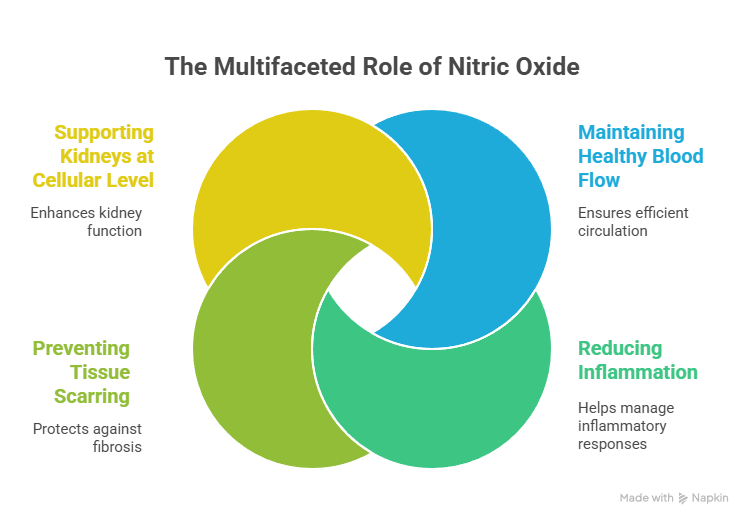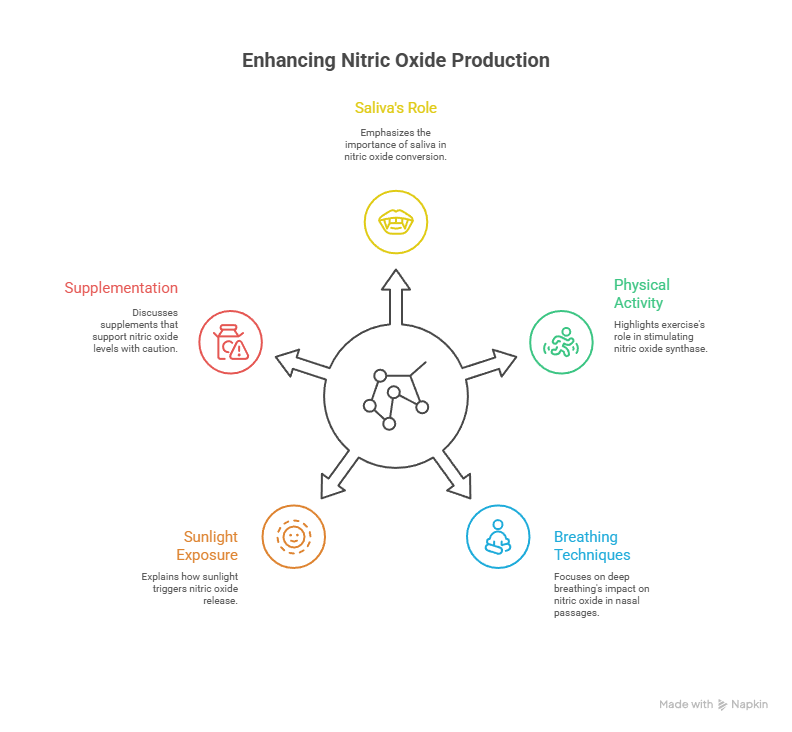
Introduction: A Silent Defender of Kidney Health
When people think about protecting their kidneys, they often think of lowering their blood pressure, controlling their blood sugar, and avoiding excessive salt or protein. While all of these are important, there’s a powerful, naturally occurring molecule in the body that rarely gets the spotlight it deserves: nitric oxide.
This humble molecule may not sound impressive, but it plays a central role in maintaining healthy blood flow, reducing inflammation, preventing tissue scarring, and supporting the kidneys at a cellular level. It is a critical messenger, helping your blood vessels relax, your immune system function, and your organs thrive.
In this blog, I want to highlight how nitric oxide offers a natural, values-aligned strategy for improving kidney health and blood pressure, especially for those navigating chronic kidney disease (CKD), hypertension, or metabolic issues.
The Overlooked Role of Nitric Oxide in Kidney Health
Nitric oxide is a gas produced naturally by the body, and its job is to help your blood vessels dilate, or widen. This allows for better blood flow, which is absolutely essential for organs like the kidneys that filter large volumes of blood every day.
Healthy nitric oxide levels are associated with:
- Improved circulation to the kidneys
- Balanced blood pressure
- Reduced inflammation within kidney tissues
- Protection against oxidative stress and fibrosis
The kidneys are highly vascular organs, meaning they rely on healthy blood vessels to do their job. Without adequate nitric oxide, the small arteries that feed the kidneys can stiffen, narrow, or become inflamed, contributing to high blood pressure and progressive kidney damage.
This is not just a theory. In my clinical practice, I’ve seen numerous patients experience improvements in kidney function and blood pressure once we focus on restoring this critical molecule.
The Downward Spiral: When Nitric Oxide Levels Decline
Unfortunately, nitric oxide levels naturally decline with age, and the decline can be even steeper in individuals with:
- Chronic kidney disease
- Diabetes
- High blood pressure
- Obesity
- Sedentary lifestyles
- Diets low in nitrate-rich foods
The result? A vicious cycle:
- Reduced nitric oxide leads to narrower blood vessels and higher blood pressure.
- Poor blood flow to the kidneys reduces their ability to filter toxins.
- Inflammation and oxidative stress increase, further damaging blood vessels and kidney cells.
- This damage reduces nitric oxide even more, amplifying disease progression.
What’s troubling is that this cycle often goes unnoticed. A patient may be doing "everything right" , taking medications, watching salt intake, checking blood pressure , but still experiences a slow decline in kidney function. The missing piece? Optimizing nitric oxide naturally.
Nitric Oxide: More Than Just a Vasodilator
Let’s go beyond blood pressure and explore nitric oxide’s multi-dimensional role in the body , especially for kidney patients.
1. Vasodilation
The most well-known role of nitric oxide is relaxing the inner muscles of blood vessels, allowing them to widen. This increases blood flow to organs, reduces blood pressure, and helps kidneys receive the oxygen and nutrients they need.
2. Anti-Inflammatory Effects
Nitric oxide helps regulate immune responses, calming excessive inflammation that can damage kidney tissues.
3. Anti-Fibrotic Benefits
Fibrosis is a process where healthy tissue is replaced by scar tissue. Nitric oxide helps prevent and slow fibrosis, a major contributor to kidney failure.
4. Antioxidant Defense
Nitric oxide supports the body’s natural antioxidant systems, helping to neutralize harmful free radicals and reduce oxidative damage , a common issue in both CKD and hypertension.
This range of benefits reflects the functional medicine principle of targeting root causes rather than just symptoms. When nitric oxide is restored, we see ripple effects across the entire cardiovascular and renal systems.
Case Study: Restoring Kidney Function Through Nitric Oxide
One of my patients, a 58-year-old woman with stage 3 CKD and long-standing high blood pressure, came to me frustrated. She was eating healthfully, exercising when she could, and taking her prescribed medications, yet her kidney function continued to decline.
Initial Findings:
- GFR: 42
- Blood pressure: 148/92
- Complaints: fatigue, swelling, poor circulation, brain fog
- Lab results indicated oxidative stress and poor endothelial (blood vessel) function
We introduced a personalized plan focused on nitric oxide restoration through nutrition, movement, and stress management. Within 4 months:
- Her GFR improved to 48
- Blood pressure averaged 124/78
- Energy returned, swelling resolved
- She reported better sleep and mental clarity
This case is a testament to what’s possible when we empower the body to heal, rather than just suppress symptoms.
Natural Strategies to Boost Nitric Oxide
The beauty of nitric oxide is that you can naturally support its production through lifestyle and dietary changes. Here are the methods I use most often with patients:
1. Nitrate-Rich Foods
Certain vegetables are naturally high in nitrates, which the body converts into nitric oxide. Include:
- Beets
- Arugula
- Spinach
- Lettuce
- Celery
- Swiss chard
These foods are not only nitrate-rich but also provide phytonutrients that support kidney and cardiovascular health.
2. Chew Your Food & Avoid Mouthwash
This may sound surprising, but your saliva is a key part of the nitric oxide production process. Antibacterial mouthwashes can destroy the oral bacteria needed to convert dietary nitrates into nitric oxide.
3. Regular Physical Activity
Exercise stimulates nitric oxide synthase, the enzyme responsible for producing nitric oxide in blood vessels. Walking, strength training, yoga, or cycling can all support this pathway.
4. Breathing Techniques
Deep, diaphragmatic breathing supports nitric oxide production in the nasal passages and reduces stress , a double win for kidney and vascular health.
5. Sunlight Exposure
Moderate sunlight on your skin and through your eyes (early morning sun) helps trigger nitric oxide release. It also improves circadian rhythm and supports hormone balance.
6. Targeted Supplementation (With Caution)
Supplements like L-arginine, L-citrulline, and beetroot extract can support nitric oxide levels, but kidney patients need to use these under supervision. Some amino acids can affect potassium levels or interact with medications, so personalization is essential.

Core Values in Action: A Holistic View of Healing
I believe that true kidney healing occurs when we lead with values, not just protocols. Supporting nitric oxide is not just about boosting a molecule , it’s about embracing a way of healing that honors the whole person.
Here’s how the nitric oxide strategy reflects key values I hold in practice:
1. Empowerment Through Education
When patients learn about the root causes of their illness , like low nitric oxide , they feel more confident, engaged, and proactive.
2. Food as Medicine
Nitrate-rich vegetables are simple, delicious, and healing. Eating for nitric oxide is not restrictive , it’s liberating.
3. The Body Can Heal
The body is designed to repair itself when given the right tools. Supporting nitric oxide reminds us that healing is possible, even in chronic conditions.
4. Prevention Over Reaction
Rather than waiting for kidney function to crash or blood pressure to skyrocket, we focus on early, gentle support , preventing future damage.
5. Personalized Care Matters
There is no one-size-fits-all approach. We always tailor nitric oxide strategies to each person’s labs, symptoms, and lifestyle.
Common Questions I Hear
“Can nitric oxide help reverse kidney disease?”
While it’s not a cure, restoring nitric oxide can slow progression, reduce inflammation, and improve blood flow. Many patients experience stabilization or improvement when this molecule is supported.
“Is beet juice safe for kidney patients?”
Beet juice is high in potassium, which may not be safe for all CKD stages. In many cases, we opt for small portions of cooked beets or arugula instead. Always consult a provider before major dietary changes.
“How quickly can I see results?”
Most patients feel more energy and better circulation within weeks. Improvements in blood pressure and kidney labs typically take 1 to 3 months.
Final Thoughts: The Power of Small Shifts
Nitric oxide may be a tiny molecule, but its impact is profound. Supporting it through thoughtful, natural strategies can lead to greater vitality, clearer thinking, improved circulation, and protection for the kidneys you depend on every day.
If you’re living with kidney disease or struggling to manage your blood pressure, remember: there are always steps you can take. Healing doesn’t always require more medications , sometimes, it starts with breathing better, eating smarter, and believing in your body’s ability to regenerate.
Ready to Reclaim Your Kidney Health?
If you’re curious about how nitric oxide support and functional medicine can fit into your kidney care plan, I invite you to schedule a consultation at The Kidney Institute. Together, we’ll build a plan that aligns with your values, goals, and deepest potential for healing.
Your body was designed to heal. Let's give it what it needs , starting with your breath, your plate, and your mindset.
